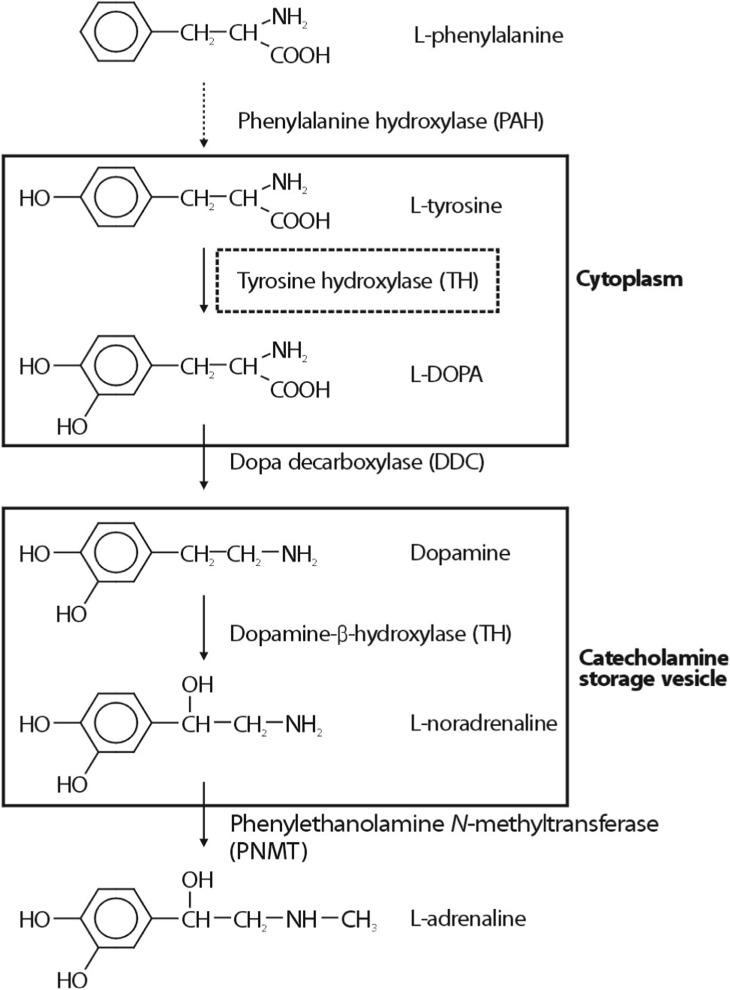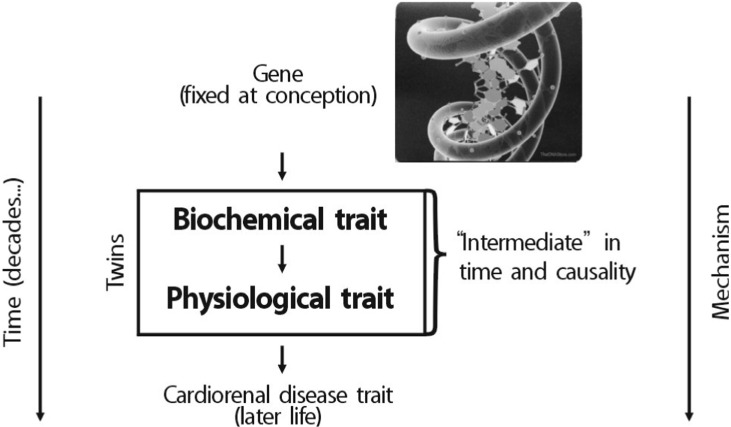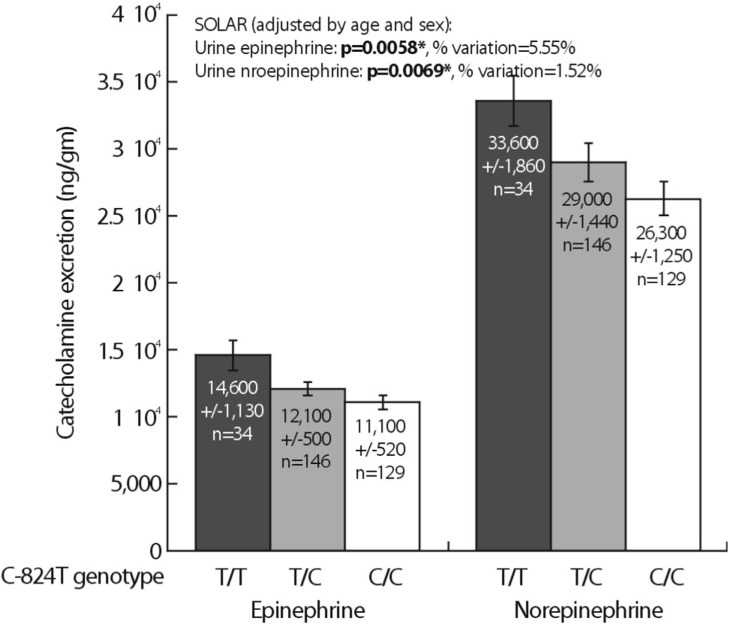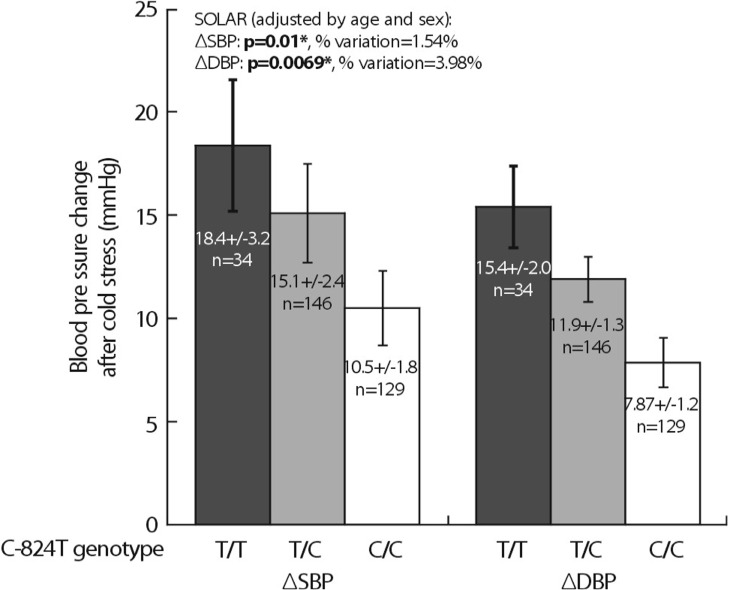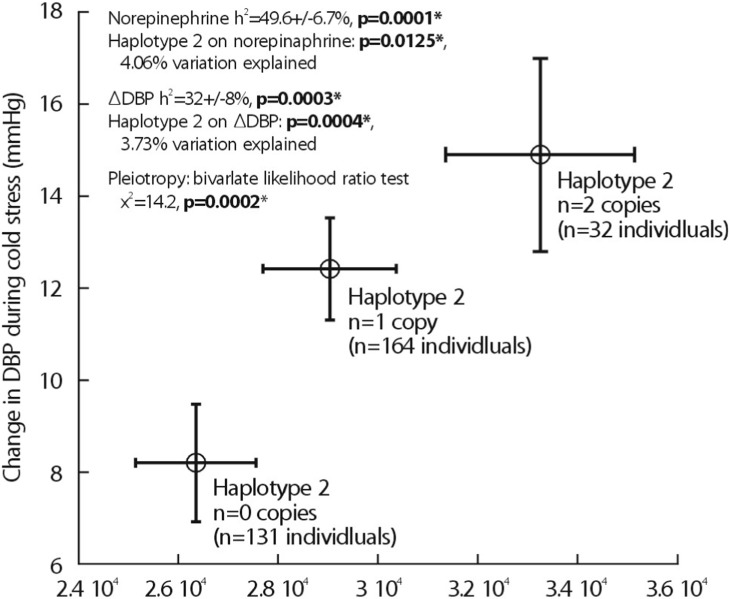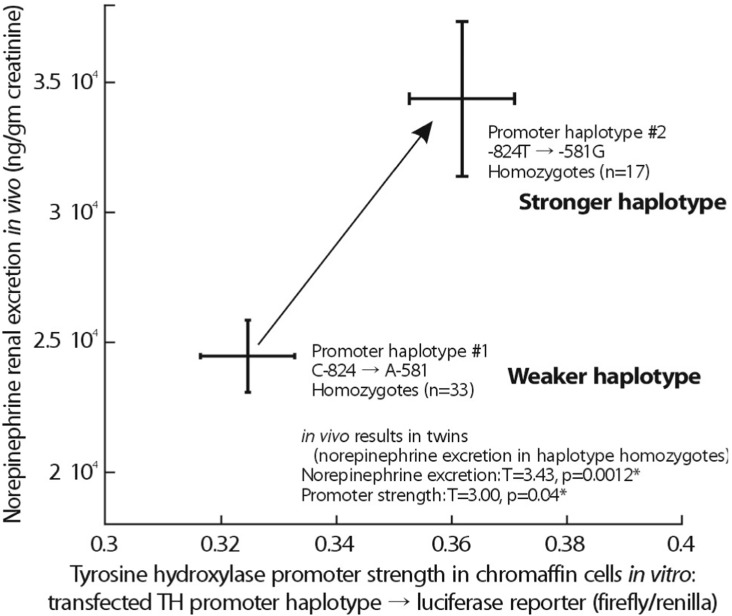Electrolyte Blood Press.
2013 Jun;11(1):24-28. 10.5049/EBP.2013.11.1.24.
Adrenergic Genetic Mechanisms in Hypertension and Hypertensive Kidney Disease
- Affiliations
-
- 1Department of Nephrology, College of Medicine, Inje University, Busan, Korea. kswnephrology@hotmail.com
- KMID: 2168397
- DOI: http://doi.org/10.5049/EBP.2013.11.1.24
Abstract
- Catecholamine secretory traits were significantly heritable, as were stress-induced blood pressure changes. Tyrosine hydroxylase (TH) is the rate-limiting enzyme in catecholamine biosynthesis. In the tyrosine hyroxylase promoter, significant associations were found for urinary catecholamine excretion and for blood pressure response to stress. TH promoter haplotype 2 (TGGG) showed pleiotropy, increasing both norepinephrine excretion and blood pressure during stress. In hypertension, 2 independent case-control studies (1,266 subjects with 53% women and 927 subjects with 24% women) replicated the effect of C-824T in the determination of blood pressure. Chromogranin A (CHGA) plays a fundamental role in the biogenesis of catecholamine secretory granules. Changes in the storage and release of CHGA in clinical and experimental hypertension prompted us to study whether genetic variation at the CHGA locus might contribute to alterations in autonomic function, and hence hypertension and its target organ consequences such as hypertensive kidney disease (nephrosclerosis). Systematic polymorphism discovery across the human CHGA locus revealed such regulatory regions as the proximal promoter and 3'-UTR. In chromaffin cell-transfected CHGA 3'-UTR and promoter/luciferase reporter plasmids, the functional consequences of the regulatory/non-coding allelic variants were documented. Variants in both the proximal promoter and the 3'-UTR displayed statistical associations with hypertension and hypertensive end stage renal disease. Therefore, I would like to review the common genetic variation in TH and CHGA as a cause of inter-individual variation in sympathetic activity, and ultimately blood pressure and hypertensive kidney disease.
MeSH Terms
-
Blood Pressure
Case-Control Studies
Chromogranin A
Female
Genetic Variation
Genomics
Haplotypes
Humans
Hypertension
Kidney
Kidney Diseases
Kidney Failure, Chronic
Norepinephrine
Plasmids
Regulatory Sequences, Nucleic Acid
Secretory Vesicles
Tyrosine
Tyrosine 3-Monooxygenase
Organelle Biogenesis
Chromogranin A
Norepinephrine
Tyrosine
Tyrosine 3-Monooxygenase
Figure
Reference
-
1. Takiyyuddin MA, Cervenka JH, Sullivan PA, Pandian MR, Parmer RJ, Barbosa JA, O'Connor DT. Is physiologic sympathoadrenal catecholamine release exocytotic in humans? Circulation. 1990; 81:185–195. PMID: 2404624.
Article2. Mahapatra NR, O'Connor DT, Vaingankar SM, Hikim AP, Mahata M, Ray S, et al. Hypertension from targeted ablation of chromogranin A can be rescued by the human ortholog. J Clin Invest. 2005; 115:1942–1952. PMID: 16007257.
Article3. Cadman PE, Rao F, Mahata SK, O'Connor DT. Studies of the dysglycemic peptide, pancreastatin, using a human forearm model. Ann NY Acad Sci. 2002; 971:528–529. PMID: 12438174.
Article4. Strub JM, Goumon Y, Lugardon K, Capon C, Lopez M, Moniatte M, et al. Antibacterial activity of glycosylated and phosphorylated chromogranin A-derived peptide 173-194 from bovine adrenal medullary chromaffin granules. J Biol Chem. 1996; 271:28533–28540. PMID: 8910482.
Article5. Mahata SK, O'Connor DT, Mahata M, Yoo SH, Taupenot L, Wu H, et al. Novel autocrine feedback control of catecholamine release. A discrete chromogranin a fragment is a noncompetitive nicotinic cholinergic antagonist. J Clin Invest. 1997; 100:1623–1633. PMID: 9294131.
Article6. Mahata SK, Mahata M, Parmer RJ, O'Connor DT. Desensitization of catecholamine release. The novel catecholamine release-inhibitory peptide catestatin (chromogranin A344-364) acts at the receptor to prevent nicotinic cholinergic tolerance. J Biol Chem. 1999; 274:2920–2928. PMID: 9915830.7. Hsiao RJ, Parmer RJ, Takiyyuddin MA, O'Connor DT. Chromogranin A storage and secretion: sensitivity and specificity for the diagnosis of pheochromocytoma. Medicine (Baltimore). 1991; 70:33–45. PMID: 1988765.8. O'Connor DT. Plasma chromogranin A. Initial studies in human hypertension. Hypertension. 1985; 7:I76–I79. PMID: 3997234.9. Takiyyuddin MA, Cervenka JH, Hsiao RJ, Barbosa JA, Parmer RJ, O'Connor DT. Chromogranin A. Storage and release in hypertension. Hypertension. 1990; 15:237–246. PMID: 2406199.
Article10. Vaingankar SM, Li Y, Biswas N, Gayen J, Choksi S, Rao F, et al. Effects of chromogranin A deficiency and excess in vivo: biphasic blood pressure and catecholamine responses. J Hypertens. 2010; 28:817–825. PMID: 20139771.
Article11. Vaingankar SM, Li Y, Corti A, Biswas N, Gayen J, O'Connor DT, Mahata SK. Long human CHGA flanking chromosome 14 sequence required for optimal BAC transgenic "rescue" of disease phenotypes in the mouse Chga nockout. Physiol Genomics. 2010; 41:91–101. PMID: 20009010.12. Chen Y, Rao F, Rodriguez-Flores JL, Mahapatra NR, Mahata M, Wen G, et al. Common genetic variants in the chromogranin A promoter alter autonomic activity and blood pressure. Kidney Int. 2008; 74:115–125. PMID: 18432188.
Article13. Chen Y, Rao F, Rodriguez-Flores JL, Mahata M, Fung MM, Stridsberg M, et al. Naturally occurring human genetic variation in the 3'-untranslated region of the secretory protein chromogranin A is associated with autonomic blood pressure regulation and hypertension in a sexdependent fashion. J Am Coll Cardiol. 2008; 52:1468–1481. PMID: 19017515.
Article14. O'Connor DT, Insel PA, Ziegler MG, Hook VY, Smith DW, Hamilton BA, Taylor PW, Parmer RJ. Heredity and the autonomic nervous system in human hypertension. Curr Hypertens Rep. 2000; 2:16–22. PMID: 10982526.15. Lillie EO, O'Connor DT. Early phenotypic changes in hypertension: a role for the autonomic nervous system and heredity. Hypertension. 2006; 47:331–333. PMID: 16446388.16. Rana BK, Insel PA, Payne S, Abel K, Beutler E, Ziegler MG, Schork NJ, O'Connor DT. Genetic Basis of a Complex Human Trait: Genes Interact with Sex to Determine Blood Pressure in a Very Large Population-Based Sample. Hypertension. 2007; 49:96–106. PMID: 17159089.
- Full Text Links
- Actions
-
Cited
- CITED
-
- Close
- Share
- Similar articles
-
- Anesthetic Management of a Child with Neuroblastoma with Hypertension: A case report
- Hypertensive Retinopathy and Associated Target Organ Damage in Korean Hypertensive Patients
- Hypertension and Male Fertility
- The Effects of the beta2-Adrenergic Receptor Gene Polymorphism on the Risk of Essential Hypertension
- Hypertension in Kidney Transplantation Recipients: Effect on Long-term Renal Allograft Survival

